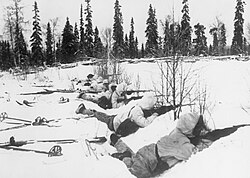
| Timelines of World War II |
|---|
| Chronological |
| By topic |
| By theatre |
| World War II |
|---|
| Navigation |
This is a timeline of World War II events that took place in 1940, the first full year of the second global war of the 20th century.

| Timelines of World War II |
|---|
| Chronological |
| By topic |
| By theatre |
| World War II |
|---|
| Navigation |
This is a timeline of World War II events that took place in 1940, the first full year of the second global war of the 20th century.









